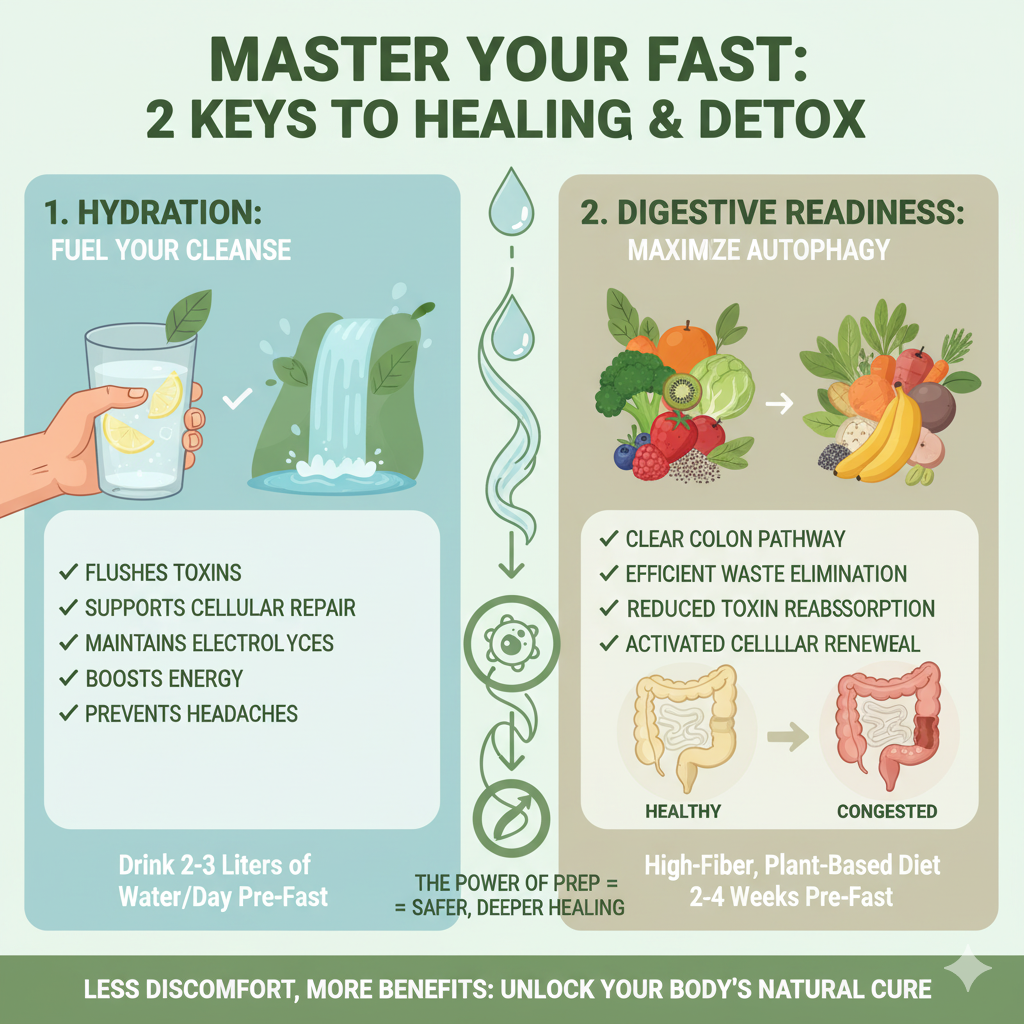Fasting for Disease Cure — A Proven Natural Method to Detox, Heal, and Strengthen Immunity
Fasting for disease cure represents an ancient healing practice gaining renewed attention in modern wellness and medical research. Unlike casual or religious fasting, therapeutic fasting involves supervised, intentional abstinence from food to promote detoxification, cellular repair, and metabolic renewal. When properly implemented, fasting for disease cure can help your body address chronic inflammation, insulin resistance, autoimmune conditions, and even support recovery from acute infections.
Research confirms that fasting triggers autophagy—a cellular “clean-up” process that removes damaged cells and toxins—while reducing oxidative stress and improving immune function. While not a universal solution, fasting for disease cure serves as a powerful complementary approach to restoring health when used wisely under proper guidance.
This comprehensive guide explores how fasting for disease cure works, which conditions may benefit, practical implementation steps, and crucial safety considerations.
How Fasting for Disease Cure Supports Healing and Recovery
Therapeutic fasting can be a powerful approach to disease management because it enables your body to shift from digestion to repair mode. As highlighted in the National Center for Biotechnology Information’s comprehensive overview of the therapeutic fasting mechanism, insulin levels drop significantly during a fast, prompting your system to burn stored fat for energy. This metabolic switch can reduce inflammation, support hormone balance, and activate key healing pathways including autophagy and stem cell regeneration.
Clinical studies demonstrate promising applications for fasting for disease cure in addressing:
- Type 2 diabetes and metabolic syndrome – fasting increases insulin sensitivity and supports glycemic control
- Autoimmune conditions – reduces inflammatory markers and calms overactive immune responses
- Cardiovascular health – improves blood pressure, cholesterol levels, and vascular function
- Neurological disorders – supports brain health and may reduce neurodegenerative disease risk
- Cancer support – enhances chemotherapy efficacy while reducing side effects (adjuvant therapy only)
Medical researchers continue to explore mechanisms behind fasting for disease cure, particularly its role in cellular renewal and systemic inflammation reduction.
Summary Practical Implementation: How to Safely Begin Fasting for Disease Cure
If you are new to therapeutic fasting, start slowly and prioritize safety. Follow this structured protocol for short-term fasting for disease cure.
Pre-Fast Preparation (2-3 days):
- Transition to whole-food, plant-heavy meals
- Eliminate processed foods, sugars, and caffeine
- Increase water and herbal tea consumption
During the Fast (24-48 hours for beginners):
- Maintain electrolyte balance with mineral supplementation
- Prioritize rest and avoid strenuous activity
- Monitor symptoms: normal responses include hunger, mild lightheadedness, or tongue coating
Breaking the Fast Safely:
- Introduce easily digestible foods: vegetable broth, steamed greens, or fresh fruit
- Gradually reintroduce solid foods over several hours
- Avoid large meals, heavy fats, or animal proteins initially
Immediate Termination Signs:
Stop immediately if you experience severe weakness, confusion, heart palpitations, or fainting. Seek medical attention if symptoms persist.
Extended fasts (3+ days) require professional medical supervision for safe implementation of fasting for disease cure.
Responsible Practice: Why Preparation and Guidance Matter
While fasting for disease cure offers remarkable potential for healing, it is not a magic solution. The rising popularity of detox trends and unverified online fasting protocols has unfortunately led many people to experiment unsafely—especially those following restrictive diets like extreme Keto or Carnivore plans. These dietary patterns can destabilize metabolic balance, making the transition into fasting more stressful for the body.
True therapeutic fasting benefits only emerge when fasting is undertaken gradually, from a foundation of nutritional balance and cellular stability. Before any extended fast, your system should already be accustomed to whole, plant-rich foods for several months. This helps your organs detoxify efficiently and reduces the risk of electrolyte imbalance or nutrient depletion during fasting.
Fasting and the Body’s Cleansing Mechanisms
In the context of fasting for disease cure, hydration and digestive readiness are two of the most overlooked yet crucial factors. Fasting naturally triggers autophagy, but when the digestive tract is congested with undigested proteins, processed residues, or mucus buildup, the detox process can become counterproductive. Maintaining a clear colon through a high-fiber, plant-based diet for several weeks before a fast allows your body to eliminate waste efficiently, reducing toxin reabsorption.

Proper hydration—typically between 1.5 and 2 gallons of clean water daily—is equally vital. Water supports kidney filtration, dilutes metabolic acids, and eases the movement of toxins through the lymphatic system. As our article on benefits of water for health outlines, without adequate hydration, detoxified waste can concentrate in the bloodstream, potentially leading to fatigue or inflammation instead of healing. Therefore, mindful hydration is central to experiencing the full therapeutic fasting benefits safely and effectively.
The Right Mindset: Fasting as a Tool, Not a Shortcut
A key insight in modern wellness science is that fasting for disease cure is most effective when integrated into a long-term lifestyle of mindful nourishment—not used as a “quick fix” after poor eating choices. The human body thrives on consistency; alternating between unhealthy eating and extreme fasting creates metabolic instability that hinders healing. Therapeutic fasting benefits are sustained only when fasting complements, rather than compensates for, a healthy diet and lifestyle.
Furthermore, the fast itself should be accompanied by rest—both physical and mental. Reducing activity, engaging in quiet reflection, and conserving energy allows the body to channel its resources toward cellular repair and immune regeneration. Fasting is not deprivation—it is an intentional pause that gives your body the space to restore harmony, strengthen resilience, and realign with its natural rhythm of healing.
Frequently Asked Questions About Fasting for Disease Cure
Q: Can fasting cure chronic illness?
A: As discussed in our detailed guide on fasting’s health benefits for disease prevention and chronic condition management, structured fasting can significantly improve symptoms and address the underlying causes of many chronic illnesses by reducing inflammation and supporting healthier metabolic processes. It works best when integrated into a comprehensive healing protocol tailored to the individual.
Q: Is fasting for disease cure safe for underweight individuals?
A: Underweight individuals need to be especially cautious. Even short-term fasting for disease cure should only be attempted under medical supervision and limited to brief periods (around 12–16 hours). This helps prevent muscle loss, nutrient deficiencies, and imbalances that could compromise recovery.
Q: What distinguishes fasting for disease cure from starvation?
A: Fasting for disease cure is a voluntary, structured practice aimed at triggering healing responses such as reduced inflammation, improved metabolic balance, and cellular repair. Starvation, by contrast, is an involuntary and prolonged lack of nutrients that damages tissues and weakens the body rather than restoring health.
Q: How does fasting for disease cure support the immune system?
A: Research suggests that properly guided fasting for disease cure can help reset immune function by lowering chronic inflammation, supporting the regeneration of white blood cells, and activating cellular repair mechanisms. These effects may strengthen the body’s natural defenses and enhance overall resilience.
